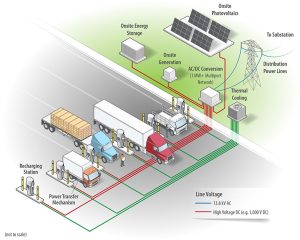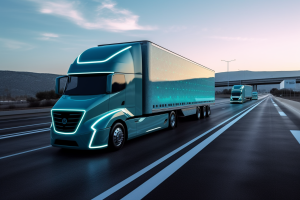The Rise of EV Charging Infrastructure

The $7 million funding from the U.S. Department of Energy signifies a landmark step towards bolstering EV charging infrastructure in the country.
The U.S. Department of Energy has made a significant stride in advancing the country’s clean energy future, dedicating $7 million in funding to seven projects aiming to develop regional electric vehicle (EV) charging infrastructure plans. These projects will not only facilitate electric charging for medium and heavy-duty trucks but will also provide hydrogen fueling options along major transportation routes across the nation.
The National Renewable Energy Laboratory (NREL) will bring their expertise to four of these projects, aiming to provide insights and recommendations for a zero-emission charging infrastructure spanning more than half of the United States.
“According to NREL, the electrification and hydrogen fueling corridor planning projects play an instrumental role in achieving federal clean energy targets. These goals include decarbonizing the U.S. transportation sector by 2050 and deploying over 500,000 EV chargers nationwide by 2030.”
The Critical Role of EV Charging Infrastructure in Federal Clean Energy Targets

The funded projects, with their focus on electric vehicle corridors and hydrogen fueling stations, have the potential to revolutionize the transportation landscape.
The development of infrastructure for battery-electric and hydrogen-fueled vehicles can significantly reduce carbon emissions and improve air quality. This improvement is particularly noteworthy in areas near freight corridors and major highways.
Enjoying our insights?
Subscribe to our newsletter to keep up with the latest industry trends and developments.
Stay InformedHow Does EV Charging Infrastructure Impact Air Quality and Carbon Emissions?
The development of infrastructure for battery-electric and hydrogen-fueled vehicles can significantly reduce carbon emissions and improve air quality. This improvement is particularly noteworthy in areas near freight corridors and major highways.

NREL’s involvement in four out of seven projects solidifies their integral role in advancing sustainable transportation solutions. NREL campus in Golden, Colorado (U.S. Department of Energy from United States, Public domain, via Wikimedia Commons)
What Projects Will the Department of Energy Fund?
NREL researchers are supporting four of the seven projects the DOE is funding. Here’s a detailed look at each of them.
Infrastructure Along The I-95 Freight Corridor

The I-95 Freight Corridor project aims to deploy optimal EV charging and hydrogen refueling sites, a critical move in decarbonizing goods transportation.
Infrastructure Along The I-95 Freight Corridor: In collaboration with Calstart, NREL researchers will develop infrastructure deployment plans along the I-95 freight corridor, spanning from Savannah, Ga., to Newark, N.J. This project will analyze goods movement, energy demands, and infrastructure requirements to identify optimal locations for EV charging and hydrogen refueling sites.
Department of Energy’s Plan for Hydrogen Fueling Stations Along I-80
Hydrogen Fueling Stations Along I-80: Cummins will lead NREL researchers in developing comprehensive plans for battery-electric charging and hydrogen fueling stations along a segment of I-80 that crosses Illinois, Indiana, and Ohio. The goal of this project is to establish a network of charging and fueling stations that will support the transition of 30 percent of the medium and heavy-duty fleets in the region to zero-emission technologies by 2035.
What is the Approach for Electrification Along Utah’s Wasatch Front?
Electrification Along Utah’s Wasatch Front: In a joint effort with a team from Utah State University, NREL researchers will assist in developing an action plan for corridor electrification along Utah’s Wasatch Front. By providing operational data on commercial vehicles, expertise in EV charging and grid interconnection analyses, and input on hydrogen infrastructure requirements, this project aims to address equity concerns and promote sustainable transportation solutions in the region.
How Will Commercial EV Charging Along New England’s Freight Corridors be Enhanced?
Commercial EV Charging Along New England’s Freight Corridors: A National Grid-led project, in collaboration with NREL researchers, will create a detailed model of truck operations along New England’s freight corridors. This project will simulate future electric truck operations and identify ideal charging locations, covering multiple states in the region.
NREL’s EVI-X modeling suite will be used to develop a cost-effective plan for large-scale EV charging deployment. The project aims to create a blueprint for commercial EV charging deployment that can serve as an example for other regions.
The funding of these projects by the U.S. Department of Energy highlights the country’s commitment to advancing the development and deployment of EV charging infrastructure. As the nation continues to move towards a clean energy future, the focus on creating sustainable transportation solutions becomes increasingly important.
The Significance of EV Charging Infrastructure

Developing the necessary infrastructure to support battery-electric and hydrogen-fueled vehicles can significantly reduce carbon emissions and improve air quality. (Freightliner eCascadia at Electric Island)
The funding of these projects by the U.S. Department of Energy highlights the country’s commitment to advancing the development and deployment of EV charging infrastructure. As the nation continues to move towards a clean energy future, the focus on creating sustainable transportation solutions becomes increasingly important.
The Role of Hydrogen Fueling Stations in Clean Energy Transition
In addition to the development of EV charging infrastructure, the creation of hydrogen fueling stations plays a crucial role in the transition to zero-emission technologies. These stations provide a refueling option for hydrogen-fueled vehicles, another promising alternative to traditional fossil fuel-powered transportation.
Why is Decarbonizing Transportation Essential?
Decarbonizing the transportation sector is a key component of the broader goal to reduce the nation’s overall carbon footprint. By transitioning to electric and hydrogen-powered vehicles, we can significantly decrease carbon emissions and make strides towards achieving federal clean energy targets.
“The funded projects focus on major freight corridors across the United States. As these corridors are pivotal to the nation’s goods movement, their transformation can have a substantial impact on the overall sustainability of the transportation sector. Enhancing these corridors with EV charging and hydrogen refueling infrastructure is a critical step towards a more sustainable future.”
The Future of Freight Corridors
The funded projects focus on major freight corridors across the United States. As these corridors are pivotal to the nation’s goods movement, their transformation can have a substantial impact on the overall sustainability of the transportation sector. Enhancing these corridors with EV charging and hydrogen refueling infrastructure is a critical step towards a more sustainable future.
The Role of NREL in Advancing EV Charging Infrastructure

The electrification and hydrogen fueling corridor planning projects play a critical role in achieving federal clean energy targets. The National Renewable Energy Laboratory (NREL)
The National Renewable Energy Laboratory is at the forefront of these efforts, collaborating on four of the seven funded projects. With their expertise in EV charging and grid interconnection analyses, NREL plays a pivotal role in the development and deployment of EV charging infrastructure.
In conclusion, the $7 million fund from the U.S. Department of Energy marks a significant milestone in the advancement of EV charging infrastructure. It underscores the nation’s commitment to decarbonizing transportation and achieving its clean energy goals. The funded projects, with their focus on electric vehicle corridors and hydrogen fueling stations, have the potential to revolutionize the transportation landscape, paving the way for a sustainable future.
Delve Further into Associated Subjects:
- Stay updated on the evolution of Electric Trucks in the transportation industry.
- Learn more about the current status and future plans of Infrastructure development in the United States.
- Understand the significance of Highway Funding for the development and maintenance of the nation’s roadway infrastructure.
- Dive into the exciting world of Hydrogen as a fuel source for medium and heavy-duty vehicles.
- Learn about the impact of the trucking industry on Emissions and the strategies being implemented to reduce them.
- Learn more about the initiatives and policies of the Department of Energy related to the transportation sector.
Dive Deeper into Industry Information:
- National Renewable Energy Laboratory (NREL): Discover more about NREL’s research and development in renewable energy and energy efficiency.
- Learn more about the projects in which NREL is helping to electrify 4 major freight corridors.
- CALSTART: Learn about CALSTART’s mission to advance clean transportation technologies and accelerate their commercialization.
- Get more details on the Biden-Harris Administration’s funding for zero-emission medium- and heavy-duty vehicle corridors and the expansion of EV charging in underserved communities.




















